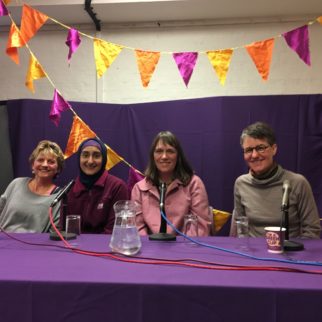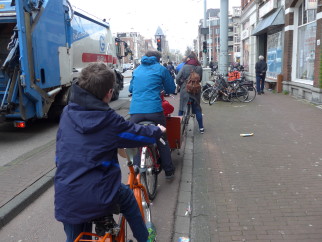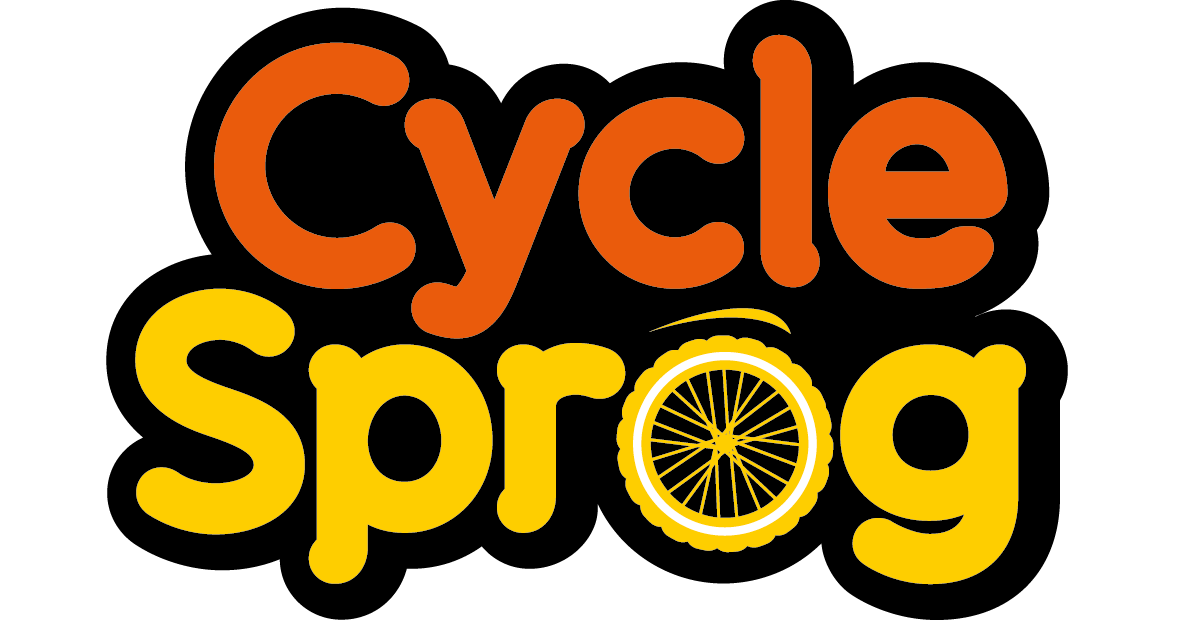From Potties to Pot Holes: the Women and Bikes Family Cycling Panel
It was a privilege to be asked to chair the Family Cycling panel discussion at the Women and Bicycles Festival 2017 (or WAB2017 for short). It was my first time chairing a panel – it’s harder work than it looks!
Karen from @CycleSprog introducing the panel. Family riding topic. Amazing panel of awesome women #WAB2017 #outdoorwomen #WomenAndBicycles pic.twitter.com/zwGlDw0mA3
— Polly Clark (@mtnyogabreaks) March 5, 2017
Here’s a summary of the main themes of the discussion. The four panellists were all inspirational women who have been instrumental in getting more families and children cycling.

From left to right in the photo they are:
Josie Dew, adventure cyclists, writer and mother of 3 children aged between 3 and 10. She’s cycled almost 500,000 miles and didn’t let becoming a mum stop her. She’s also patron of Sustrans and Vice President of Cycling UK.
Maryam Amatullah, an award winning cycle trainer, who has done fantastic work helping women and children, particularly from BEM backgrounds, learn to cycle. Maryam has three grown up children, and her first grandchild is due within the next week.
Carolyn Roberts, a mum of four boys aged between 16 and 9. Over the years she’s developed a love of cargo bikes that she’s turned into a business called Kids and Family Cycling, selling a wide range of family cycling equipment.
Isla Rowntree, founder of children’s bike company Islabikes, who has done more than anyone to change the way the bike industry views children’s bikes.
There’s more information about the family cycling panellists at WAB2017 in this article I wrote prior to the event if you’re interested.
Memories of cycling as a child
A common theme amongst the panellists was the sense of freedom being on a bike had given them when they were young. You didn’t cycle with your parents – you cycled to get away from them! From Josie going on cycle tours of Cornwall and the Isle of Wight as a teenager to Maryam spending her weekends riding to and around at the local outdoor cycle track, there was a real sense of a bike being your key to freedom.
'For kids bikes = freedom! it's the first thing you own which is not a toy' @IslaRowntree #WomenAndBikes pic.twitter.com/xFFECxR9UT
— Broken Spoke Bike Co-op (@BrokenSpokeCoop) March 5, 2017
The panelists all remembered a time when parents used to let their kids out on their bikes for hours and sometimes days on end. We all agreed that this is a freedom that today, many children just miss out on – partly due to the amount of traffic on the road and partly due to parents’ (and society’s) attitude to what is acceptable for children and young people to be doing.
Maryam explained how so many girls currently get put off cycling when they reach about year 8 as they become very image-conscious. Teenage girls worry about being seen as “uncool” and equate cycling with getting hot and sweaty with messed up hair. This is so sad, as over the two days of the Festival one of the common themes coming from many speakers had been that cycling had been their only escape from the pressures and expectations they faced during adolescence. Normalising cycling as a method of transport, having more role models and increasing e-bike usage may help to tackle these perceptions.
Family cycling as an endurance event
The Women and Bicycles festival was jointly organised by The Adventure Syndicate, whose founders are predominately professional or elite long-distance cyclists. Some of the other discussions and workshops at WAB2017 had covered topics such as how to pack as lightly as possible for a trans-continental race, and how it’s possible to cycle 500 miles in just 36 hours. The juxtaposition of Josie and Carolyn explaining how they manage (just about) to get packed up for school and make it in time for the bell every morning was hilarious.
Josie also shared with us how to carry as much as is physically possible on a family cycling holiday, including the use of pedal toe clips for hanging things off of panniers, and cable ties to strap things on as you go along. It was encouraging to know that if you can travel a mile in a couple of hours with small children, then you’re doing well.
I thought taking 1 camping in a trailer was a feat – Josie Drew tours with 3 (+potties, toys, books etc). Much respect. #wab2017
— Mary Stevens (@maryistevens) March 5, 2017
A few more useful tips Josie shared for parents thinking of going on a family cycling holiday are:
- Remember you need time to let young children out of their trailers, cargo bikes or bike seats and run around. This adds hours to your journey time
- Plan your route around interesting places, not distance travelled
- Ice cream at the destination is always a great incentive
- You need extra space in your luggage for all the stuff (usually big and heavy) that kids like to pick up and buy along the way
- Treble how long you think it might take to get somewhere, and it will take you slightly longer
- Take two small buckets with lids – one for bums and one for bodies. You can improvise a shower out of the bodies one if they desperately need a wash, and store dirty nappies, pants etc in the other (and even use it as a bedpan in the middle of the night if you can’t be bothered to get up and empty the potty.
Josie and Carolyn both shared their experiences of coping with an expanding family. Starting off with one child strapped into a seat on the back of their bikes, they both continued to adapt their cycling set-up to cope with two, then three (and four in Carolyn’s case) growing children. Between them, they’ve used every variant of family cycling equipment you can think of – front seats, rear seats, tag-alongs, FollowMe Tandems, trailers, cargo bikes, tandems – always able to find a way of getting all of the children to school. Josie recounted how she used a massive piece of foam to secure and protect her daughter’s carry-cot in a cargo bike box when she was a few days old.
Their message was clear – there is no single prescriptive way to transport your family by bike. You adapt as your children grow, and use what fits your needs at that particular moment.
#WAB2017 how do you cycle with kids? Strap em in with a bungee and keep doing 36mph downhill: Josie Dew = legend!
— VeloVedic (@VeloVedic) March 5, 2017
The increasing availability of e-assist bikes and cargo bikes has been embraced by both women, who have both found this extra power useful as the children get older. The panel agreed that the continuing improvements in e-bike technology will be an important influencer in the future of family cycling. Knowing that you can get up a hill or back home after a trip with the kids, without ending up exhausted and sweaty, will hopefully encourage far more parents and older children to start using cargo bikes.
We discussed the view that family cycling can be seen as prohibitively expensive, but everyone agreed that buying, maintaining and running a bike or cargo bike is considerably cheaper than having a car. However, it’s not until families see cycling as an alternative, rather than an additional expense and mode of transport, will everyday cycling with children become mainstream.
Women and Bikes 2017 – Changing trends in kids bikes
With the exception of Josie’s three children, the audience at the Women and Bicycles Festival were of an age when kids were taught to ride a bike using stabilisers. Isla explained how balance bikes are now changing the way children learn to ride, allowing them to gain skills and confidence in balancing and bike handling that make the transition to a pedal bike so much easier.
We watched balance bike racing on YouTube last night @KarenGee3! Made our evening!
— VeloVedic (@VeloVedic) March 6, 2017
Isla advised that parents shouldn’t push their children to learn to ride a pedal bike too early – some children can do it before they’re 3 years old whilst others maybe 6 years or older. Every child develops the skills needed at a different pace, and as parents, we shouldn’t pressure them to do something they’re not ready for.
Looking towards the future Isla managed to give a very succinct summary of the environmental challenges facing the bicycle industry, and her work to address those with the Imagine Project. I’m not even to going to summarise as you can read a full interview with Isla Rowntree about the Imagine Project and see the prototype Imagine 20 bike itself elsewhere on Cycle Sprog.
Guess what you need to get more families cycling?
One of the themes that came out time and again during the family cycling discussion at WAB2017 was a lack of cycling infrastructure being the major barrier to getting more kids and families cycling. A white line painted on a busy road, that is full of potholes, isn’t going to encourage parents to do the school run by bike. A protected cycleway that suddenly ends when the road narrows or reaches a busy junction isn’t going to encourage parents to take their children to pre-school by bike.
The reason Josie takes her family to the Netherlands, Germany and Denmark for their family cycling adventures is that her daughters can cycle for over 6 weeks at a time without any traffic worries. All this brought back memories of taking my boys family cycling in Holland last Easter too. 
Maryam spoke poignantly about how an accident she suffered as a teenager resulted in her being too scared to cycle with her children on the road when they were young. Learning to ride safely on the road has changed her attitude and she now helps others learn how to ride confidently on the road, and can’t wait to take her granddaughter out on a bike (if she can persuade her son to say yes).
The Women and Bikes panel highlighted another way of getting more children and families using cycling as their everyday mode of transport – the use of traffic exclusion zones around schools. This has been introduced in areas of London and Edinburgh to encourage more active travel. It’s evident that a vicious circle has developed at schools. Parents don’t want to walk or cycle their child to school because there is too much traffic, so they get in the car for the very short journey to school, and causing the very problem they were complaining about in the first place. Removing the traffic from around the school helps create a virtuous circle, encouraging more parents to walk, cycle or scoot with their children.
One of the biggest rounds of applause of the day was for Josie when she told of her various attempts to confront the drivers of cars that had passed too closely to her and her children on the school run. It takes guts to stand up to neighbours and other parents, and she’s made friends and enemies along the way. She also had the room in stitches as she told of her efforts to gain more space on the road by equipping her kids with large sticks to wave around – car drivers don’t like the thought of getting their paint scratched by erratic cyclists or big sticks!
When it was noted that drivers tend to give horses a wide berth because they don’t want to get kicked, Josie announced she would dress up as a horse for the school run – now that’s a story I’d love to read about in her next book!
I think we could have talked all day about family cycling – there was so much we didn’t cover but some of the more adventurous types were getting restless for action and our discussion sadly had to come to an end.
Syndicate directors @lauralikeswater and @leecraigie_ escape from @BrokenSpokeCoop #kidsandfamilycycles panel for a test ride #WAB2017 pic.twitter.com/RKQxfpeFub
— Adventure Syndicate (@adventuresynd) March 5, 2017
It was brilliant to find out afterwards on Twitter that the panel had gone down well – some of the comments are included in this article, but you can search Twitter and Instagram with #WAB2017 for a full view of the events that took place during the festival.
Loved the #familycycling panel at @BrokenSpokeCoop @adventuresynd earlier today. 5 inspiring women right there! @IslaRowntree @KarenGee3 pic.twitter.com/D7tihmdUco
— Jennifer (@PinkMtbr) March 5, 2017
Other posts you may like:
- Interview: Isla Rowntree has imagined the future of kids bikes
- Meeting and making friends at WACC2016
- Family friendly cycle routes
- How we became a mountain biking family in just one year
- How to get more children cycling safely to your school
- Cycling with kids can make you feel like one in a million
Karen Gee chaired the Family Cycling panel at the Women and Bicycles Festival (WAB2017) that took place in Oxford on 5th – 6th March 2017.

Comments